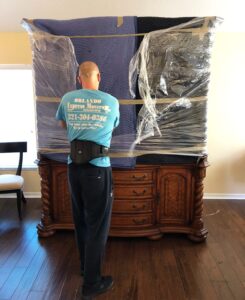Handling Fragile Items and Valuables During a Move
| Getting your Trinity Audio player ready... |
Moving to a new city or neighborhood is an exciting adventure, but it can also be a bit daunting, especially if you’re leaving behind friends and familiar faces. One of the key factors in feeling at home in your new location is building a social network and making friends. While it may seem challenging at first, there are numerous effective ways to meet new people and establish meaningful connections. In this guide, we’ll explore strategies and activities to help you make friends and build a sense of community after moving.
1. Start with a Plan
The first step in safeguarding your fragile items and valuables is to create a detailed plan. This plan should include a checklist of all the delicate items you’ll be moving, their quantities, and their current condition. Having an inventory will help you keep track of your items and assess any damage that may occur during the move for potential insurance claims.
2. Gather Packing Supplies
To protect your fragile items effectively, you’ll need the right packing supplies. Gather materials such as sturdy cardboard boxes, bubble wrap, packing paper, packing tape, packing peanuts, and foam sheets. Invest in quality materials, as they will provide better protection for your valuables.
3. Declutter and Downsize
Before you start packing, take the opportunity to declutter and downsize your belongings. Donate, sell, or dispose of items you no longer need. Reducing the number of fragile items you have to move will make the process easier and less risky.
4. Pack Delicate Items Separately
When it comes to packing fragile items, individual attention is key. Each item should be packed separately using appropriate padding. Wrap fragile items in bubble wrap or packing paper, securing it with packing tape. Make sure to fill any empty spaces in the box with packing peanuts or foam sheets to prevent items from shifting during transit.
5. Use Proper Boxes
Choose boxes that are strong and appropriately sized for your delicate items. It’s best to use new or like-new boxes as they offer better structural integrity. Avoid overloading boxes with fragile items, as this can increase the risk of breakage. Clearly label each box as “fragile” to alert movers to handle them with care.
6. Consider Custom Crates
For exceptionally fragile and valuable items, consider custom wooden crates. These provide an extra layer of protection and are often used for delicate artwork, antiques, or heirlooms. Professional movers can create custom crates tailored to your items’ dimensions.
7. Reinforce Weak Spots
Strengthen boxes and containers by adding extra layers of cardboard or foam at weak points. Corners, edges, and bottoms are common areas that may need reinforcement. The goal is to ensure that the box maintains its structural integrity throughout the move.
8. Wrap and Cushion Inside the Box
In addition to wrapping each item individually, it’s essential to provide cushioning inside the box. Place a layer of packing peanuts, foam sheets, or bubble wrap at the bottom of the box. Then, insert the wrapped fragile items and add more cushioning on top to create a protective layer.
9. Pack Plates and Dishes Vertically
When packing plates and dishes, stack them vertically in the box, similar to how you would store them in a dishwasher. Place a layer of cushioning material between each plate to prevent them from touching. Fill any gaps with packing material to prevent shifting.
10. Secure Glass and Mirrors
Glass items and mirrors require special attention. Tape an “X” shape across the glass or mirror’s surface with masking tape to reinforce it and prevent shattering. Then, wrap it in bubble wrap and place it inside a mirror or picture box.
11. Label and Organize
Clearly label each box containing fragile items with a brief description of its contents and the room it belongs to. This will help movers handle the boxes appropriately and make unpacking more efficient at your new location.
12. Consider Professional Movers
If you’re uneasy about packing and transporting fragile items yourself, consider hiring professional movers with experience in handling delicate possessions. They have the expertise, equipment, and insurance to ensure the safe relocation of your valuables.
13. Take Valuables with You
Highly valuable items, such as jewelry, important documents, or sentimental heirlooms, should be transported with you personally. Never entrust these items to movers, as they are irreplaceable.
 14. Insure Your Possessions
14. Insure Your Possessions
Regardless of how carefully you prepare, accidents can still happen during a move. Consider purchasing additional insurance coverage for your fragile and valuable items. Check with your moving company to understand their insurance policies and whether they offer specialized coverage for delicate possessions.
15. Prepare for Moving Day
On moving day, be present to supervise the handling of your fragile items. Provide clear instructions to the movers about the importance of handling these items with care. Ensure that they use proper lifting techniques and equipment to avoid accidents.
16. Conduct a Final Check
Before leaving your old residence, conduct a final check to ensure that no fragile items have been left behind. Walk through each room and inspect closets, drawers, and cabinets.
17. Unpack with Care
When you arrive at your new location, unpack your fragile items with the same care and attention you used when packing them. Start by opening the boxes labeled “fragile” first. Inspect each item for damage and report any issues to your moving company or insurance provider.
18. Store Safely
Once you’ve unpacked, consider where and how you’ll store your fragile items in your new space. Use proper storage solutions, such as cabinets with cushioned shelves or glass display cases, to protect and showcase your valuables.
In conclusion, handling fragile items and valuables during a move requires careful planning, the right materials, and attention to detail. By following these steps, you can significantly reduce the risk of damage to your delicate possessions and ensure they arrive at your new destination safely. Remember, it’s better to invest time and effort in proper packing and protection than to deal with the stress and cost of replacing or repairing damaged items after the move.

